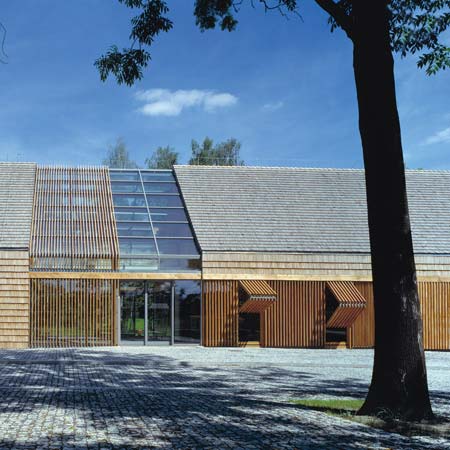Polish Design Season: db2 Architekci have completed an administrative building for a farm near Wroclaw.
Located at Opole Rural Museum, the building's shape is inspired by local rural architecture.
Wooden batons shade windows from the sun and increase security, with certain sections folding open during the day.
The roof is clad in shingles made of split logs.
The interior is divided in two by a central glazed entrance hall.
The public area is decorated in white, while an area reserved for staff is painted black.
Photographs are by Wojciech Kryński and Małgorzata Tenczyńska.
Here's some more information from db2 architekci:
--
Admin Building of the Open - Air Museum of Rural Architecture
Location
The museum is situated by the national road leading from the Opole downtown in the direction of Wroclaw, about 6 km from the city centre.
We treated the area of the Opole Rural Museum ethnographic park as a composition foundation, in which its spatial and educational advantages are most important. The new building completes and extends the already existing building arrangement.
It also refers to traditional character of the park architecture with its composition, block proportions, materials used and the interior functional plan.
The area forming principle
The rule of planning the building and its closest surroundings on the basis of two main, perpendicular directions was applied in the concept.
The administration building is located along the east-west direction. In the concept, this is the direction symbolizing tradition and linkage to historical character of the museum.
The new elements of area development are based along the north-south direction. The lines, which are continuation of elevation partition, determine the square in front of the building, the parkplace, the inner yard and the floor partition.
They also define shapes of gardens and small architecture elements. In the area, the lines are naturally restrained by the board.
The projection forming principle
The building shape refers to historical forms of rural buildings in the Opole Silesia region.
The basic projection of the dwelling building – the black and the white chambers, separated with a vestibule – reflects the new building concept.
The vestibule becomes the entrance hall, separating the accessible part (the white chamber) from the staff-only part (the black chamber).
The conference-exhibition hall and the consultation hall symbolize chambers – places for storing valuable objects – namely, the knowledge.
The elevation forming principle
The elevation concept was created as a result of putting three layers of material.
The elevation partition was inspired with a typical Silesian barn with its threshing-floor and a wooden gate on an axle.
The building pivot is a modern construction, completed with glassed elements, that let light into the building.
The biggest of those elements is situated over the main entrance.
Wood is the next part of the elevation. Traditional material is used in a modern way – for shutters protecting the interior from the sun light.
It’s also a protection against intruders, when the museum is closed.
The shutters are movable, some of them can be opened.
It influences the elevation image that is changed depending on the weather.
The last layer is a traditional roof coat material – a shake. It refers to the character of architectural surrounding.
Admin Building of the Open-Air Museum of Rural Architecture
Budynek administracyjno – recepcyjny Muzeum Wsi Opolskiej
INFO
location
adres
Budynek administracyjno – recepcyjny Muzeum Wsi Opolskiej
45-835 Opole, ul. Wrocławska 174
authors
autorzy
db2 architekci
Iwona Wilczek
Mariusz Tenczyński
Ewa Oglęcka
Jarek Oglęcki
interior design
db2 architekci
structural engineer
konstrukcja
Edward Kotula
Mariusz Owsiak
client
inwestor
Muzeum Wsi Opolskiej
general contractor
wykonawca
Energopol Trade Opole Spółka z o.o.
investment costs
koszt inwestycji
4 500 000 PLN
competition
konkurs
09.2005 – 10.2005
project
projekt
10.2005 – 03.2006
construction
budowa
11.2006 – 05.2008
site area
pow. działki
~ 13 200 m2 (included in project)
built area
pow. zabudowy
842 m2
usable floor area
pow. użytkowa
793 m2
total floor area
pow. całkowita
1 130 m2
volume
kubatura
3 680 m2
photographs
Zdjęcia
Wojciech Kryński

